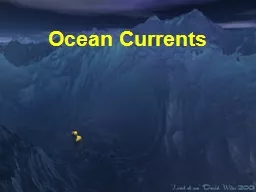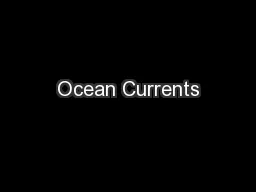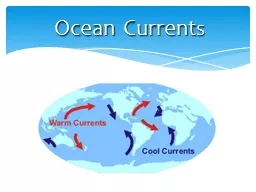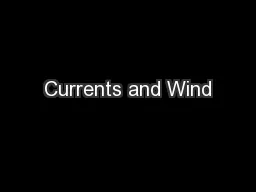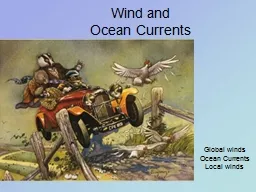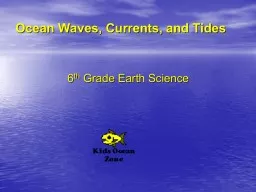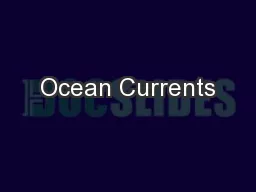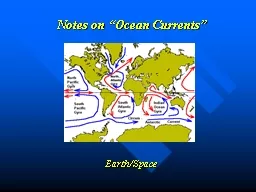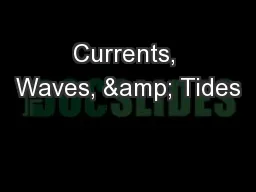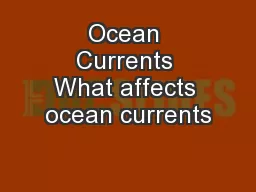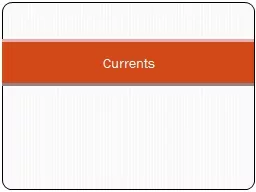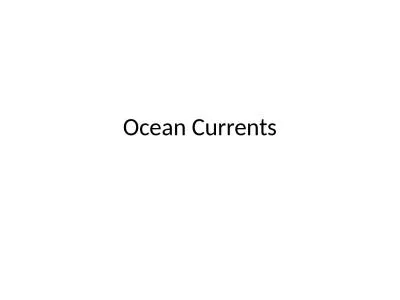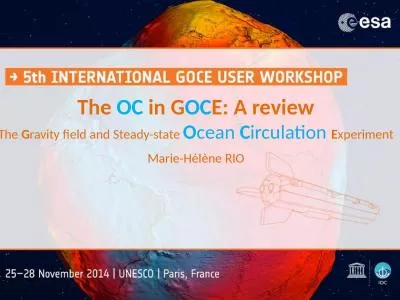PPT-Ocean Currents Why is Ocean Circulation Important?
Author : giovanna-bartolotta | Published Date : 2018-09-22
Transport heat Equator to poles Transport nutrients and organisms Influences weather and climate Influences commerce Surface Currents The upper 400 meters of the
Presentation Embed Code
Download Presentation
Download Presentation The PPT/PDF document "Ocean Currents Why is Ocean Circulation ..." is the property of its rightful owner. Permission is granted to download and print the materials on this website for personal, non-commercial use only, and to display it on your personal computer provided you do not modify the materials and that you retain all copyright notices contained in the materials. By downloading content from our website, you accept the terms of this agreement.
Ocean Currents Why is Ocean Circulation Important?: Transcript
Transport heat Equator to poles Transport nutrients and organisms Influences weather and climate Influences commerce Surface Currents The upper 400 meters of the ocean 10 Deep Water Currents. Early ocean studies. For much of human history, knowledge of the ocean and its currents was not recorded for many reasons - most sailors could not write and information was passed orally.. European nations began systematic ocean explorations but kept information secret between the 15. Vocabulary. Ocean Current. Coriolis Effect. Rip Current. Upwelling. Major Ocean Currents. An . Ocean Current. is a large volume of water flowing in a certain direction.. Wind-driven currents are called surface currents.. s. Warm. . currents flow . away. from the . equator.. Cold. currents flow . toward. the . equator.. Ocean Currents. Sun. Wind. Coriolis. Effect. Gravity. Factors Influencing Currents. Energy from the Sun heats the water.. The Earth is Spinning…. Because Earth spins, winds and water appear to be deflected in a curved motion. This is called the Coriolis Effect. Which way do things. not connected to . Earth get deflected . Currents. Ocean water contains streamlike movements of water called . ocean currents.. Currents can travel extremely far. In ancient times, currents were largely responsible for any human travel across the oceans. It is believed that currents carried the ancient Peruvians over 6,000 km across the south pacific to Polynesia. . Global winds. Ocean Currents . Local winds. Coriolis Effect. Because the Earth rotates, and consists of a mixture of land and sea, the . Coriolis Effect . exists. The . Coriolis Effect. is the movement of particles (such as air) to the right in the Northern Hemisphere. 6. th. Grade Earth Science. Currents. A current is a large stream of water that flows through the ocean. . Two types of currents. Surface Currents Deep Currents. The water in the ocean moves in giant streams called currents.. Scientists place ocean currents into two major categories: surface currents and deep currents.. Surface . Currents. Ocean currents that occur at 328 feet deep or above. Earth/Space. S.W.B.A.T.. Explain how winds and the . Coriolis. effect influence surface currents. Discuss the temperatures of coastal waters. Describe density currents and how they affect Earth. Surface Currents. Highways in the Sea. What forces are responsible for currents?. Wind. : transfers energy through friction on surface; causes currents and waves. Sea level. : steeper slope=greater pressure gradient=drives a larger, faster current. How do different currents form. What is upwelling. What do ocean currents transfer. Predict. T F. Ocean currents are always cold. C. ontinents affect the direction of currents. Currents only flow near the surface of the ocean. wind, salinity, temperature, the Coriolis Effect, and gravitational pull.. 14)Ocean . currents flow in . predictable patterns. around the earth.. 15) Differences . in . density. and . temperature. causes currents.. For much of human history, knowledge of the ocean and its currents was not recorded for many reasons - most sailors could not write and information was passed orally.. European nations began systematic ocean explorations but kept information secret between the 15. The . G. ravity. . field. and . Steady. -state . O. cean. . C. irculation . E. xperiment. Marie-Hélène RIO. From. . Gravity. to . ocean. circulation: Basic concepts. The GOCE . breakthrough. Main .
Download Rules Of Document
"Ocean Currents Why is Ocean Circulation Important?"The content belongs to its owner. You may download and print it for personal use, without modification, and keep all copyright notices. By downloading, you agree to these terms.
Related Documents

